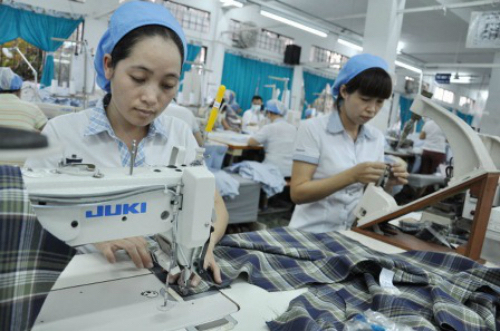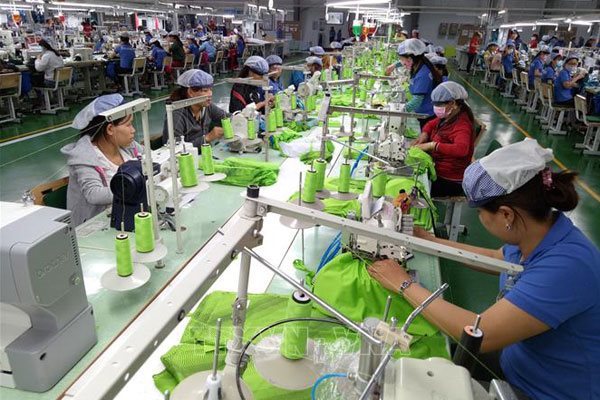- © Copyright of Vietnamnet Global.
- Tel: 024 3772 7988 Fax: (024) 37722734
- Email: evnn@vietnamnet.vn
textile & garment
Update news textile & garment
Textile and garment industry sees great opportunities in EVFTA
 A number of industries that make products for export, including textiles and garments, are expected to change for the better if they can take full advantage of the value chain from EVFTA.
A number of industries that make products for export, including textiles and garments, are expected to change for the better if they can take full advantage of the value chain from EVFTA.
Exploiting FTAs: milk and fabric companies seek opportunities
 The doors to export markets have opened after the signing of government-to-government agreements. However, enterprises still have to overcome many challenges.
The doors to export markets have opened after the signing of government-to-government agreements. However, enterprises still have to overcome many challenges.
Localization ratio in textiles & garments goes up
VietNamNet Bridge - PM Nguyen Xuan Phuc, at a conference held in late December, said the localization ratio in the textile and garments, and footwear industries, has risen to 40-45 percent.
Textile & garment, footwear industries told to expect new FDI wave
The foreign direct investment (FDI) flow into the textile & garment and footwear industries increased sharply after Vietnam signed the EU-Vietnam FTA and CPTPP, and is expected to continue to rise in the context of the US-China trade war.
Textile & garment companies earn big money in China-US trade war
VietNamNet Bridge - Vietnam’s textile & garment industry is reaping the benefits from the China-US trade war.
Vietnam sees new FDI wave in textile & garment value chain
Foreign investors have poured more money into yarn, garment and accessories projects, while Vietnam needs more projects on textile, dyeing and trimming projects to form closed textile & garment value chains.
Environment risks prompt authorities to reject textile & dyeing projects
VietNamNet Bridge - Vietnam has lured big investments into the textile & garment industry, but the projects are unwelcome in localities for fear for pollution.
Will 5 million jobs in Vietnam be lost in the 4.0 industrial revolution?
Tran Anh Tuan, deputy director of the HCMC Center for Human Resources Forecasting and Labor Market Information, said that the risk of losing jobs has increased in the 4.0 industrial revolution era.
Vietnam ready to receive South Korean investment in textile & garment sector
VietNamNet Bridge - A new investment wave is expected to hit Vietnam’s textile & garment industry in the time to come, triggered by the Vietnam-South Korea FTA.
Textile & dyeing projects unwelcome because of environmental risks
VietNamNet Bridge - Investors in the textile and garment industry are complaining that local authorities are turning down new textile and dyeing projects for fear of pollution.
Vietnam’s textile & garment industry expect big benefits from EVFTA
VietNamNet Bridge - Once the EU-Vietnam FTA (EVFTA) is signed and the tariff is cut to zero percent, textile and garment exports to the market may obtain 7-8 percent growth rate per annum, experts say.
OBM, ODM modes considered for Vietnam’s textile and production
FIEs have organized production according to the OBM mode, in which they undertake all important phases of the production chain, from design and production to distribution.
4.0 industrial revolution yet to make impact on Vietnam's textile & garment industry
VietNamNet Bridge - Garment companies have yet to feel the pressure from the 4.0 industrial revolution, which is expected to replace many workers with robots as automation becomes more widespread.
Garment manufacturers feel pressure from foreign fashion brands
VietNamNet Bridge - While Vietnamese garment companies think the domestic market is too small, foreign investors consider Vietnam the "new land" to exploit, with the garment market worth $4.5 billion.
Textile and garment industry undergoes restructuring
VietNamNet Bridge - Restructuring the textile and garment industry involves drawing up a new development strategy, using new technologies, and closing fiber and textile factories that use outdated technologies.
What's the future for textiles & garments without the TPP?
VietNamNet Bridge - With the collapse of TPP, the textile & garment industry will have to revise its investment and development strategy.
Three scenarios for textiles & garments after Trump takes office
VietNamNet Bridge - Vietnam’s textile & garment sector will maintain current growth if the US withdraws from the TPP, analysts say, but the growth would be higher if the TPP is approved by the US.
Textile & garment industry cautious about future as Trump wins US election
VietNamNet Bridge - US President-elect Donald Trump is opposed to the Trans Pacific Partnership (TPP) trade agreement. Will this affect Vietnam’s textile and garment exports to the US?
PVTex dream smashed
VietNamNet Bridge - While foreign investors flock to Vietnam, many textile projects developed by Vietnamese investors have failed, raising concerns about the future of Vietnam’s textile & garment industry.
Foreign investment in textile & garment sector falls
VietNamNet Bridge - Unlike two years ago, when Vietnam witnessed a wave of foreign direct investment (FDI) in textile & garment projects, the capital flow into the sector has slowed down.



















